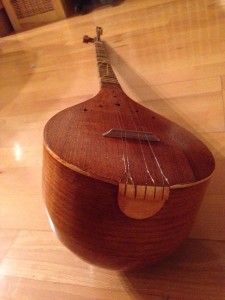History of the 6 String Guitar
drawn from How it All Began: The Origin of the Guitar by Derek Cockrum, & Stalking the Oldest 6 String Guitar by Thomas Heck
The guitar actually has a mixed heritage, but the origins of the modern instrument can be traced back to Spain. In fact, the word “guitar” is derived from the Spanish word “guitarra.” Knowing the origins of the guitar, as well as its extensive history, can help players develop a deeper respect for the instrument. In addition, knowing how the guitar has evolved helps players understand the construction of the modern guitar.
It is generally assumed that the string instruments emerged about 4000 BC from the hunting bow and the sound it produces while shooting. Around 2000 BC the Babylonians frequently made such string instruments, not only in a simple harp or lyre form, but even with a solid wooden neck and a primitive sound box of stretched animal skins. Just like the bow, the strings ware made of woven plant fibres or animal materials.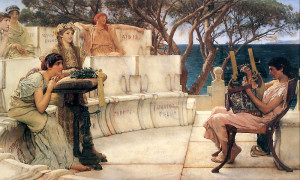
The guitar is a popular musical instrument classified as a string instrument with anywhere from 4 to 18 strings, usually having 6.
As Other Conception- The name "guitar" comes from the ancient Sanskrit word for "string" - "tar". (This is the language from which the languages of central Asia and northern India developed.) Many stringed folk instruments exist in Central Asia to this day which have been used in almost unchanged form for several thousand years, as shown by archeological finds in the area. Many have names that end in "tar", with a prefix indicating the number of strings:
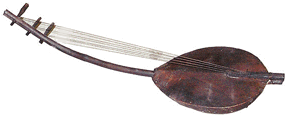 Dotar
Dotar
two = Sanskrit "dvi" - modern Persian "do" -
dotar, two-string instrument found in Turkestan
three = Sanskrit "tri" - modern Persian "se" -
setar, 3-string instrument, found in Persia (Iran),
(cf. sitar, India, elaborately developed, many-stringed)
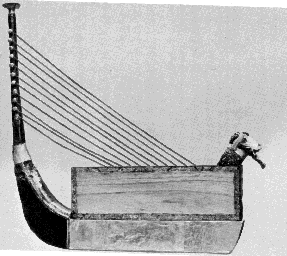 four = Sanskrit "chatur" - modern Persian "char" -
four = Sanskrit "chatur" - modern Persian "char" -
chartar, 4-string instrument, Persia (most commonly known as "tar" in modern usage)
(cf. quitarra, early Spanish 4-string guitar,
modern Arabic qithara, Italian chitarra, etc)
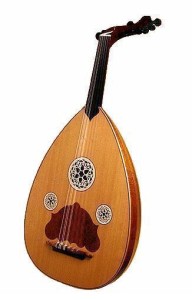 five = Sanskrit "pancha" - modern Persian "panj" -
five = Sanskrit "pancha" - modern Persian "panj" -
panchtar, 5 strings, Afghanistan
Indian Sitar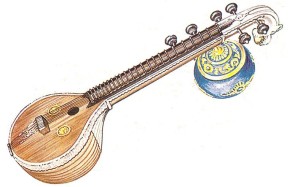
The Indian sitar almost certainly took its name from the Persian setar, but over the centuries the Indians developed it into a completely new instrument, following their own aesthetic and cultural ideals.
Persian Setar
Chartar ("Tar")
Tanburs and harps spread around the ancient world with travellers, merchants and seamen. The four-stringed Persian chartar (note the narrow waist!) arrived in Spain, where it changed somewhat in form and construction, acquired pairs of unison-tuned strings instead of single strings and became known as the quitarra orchitarra.
From four-, to five-, to six-string guitar
As we have seen, the guitar's ancestors came to Europe from Egypt and Mesopotamia. These early instruments had, most often, four strings - as we have seen above, the word "guitar" is derived from the Old Persian "chartar", which, in direct translation, means "four strings". Many such instruments, and variations with from three to five strings, can be seen in mediaeval illustrated manuscripts, and carved in stone in churches and cathedrals, from Roman times through till the Middle Ages. Right: Roman "guitar", c:a 200 CE.
Before the development of the electric guitar and the use of synthetic materials, a guitar was defined as being an instrument having "a long, fretted neck, flat wooden soundboard, ribs, and a flat back, most often with incurved sides".The term is used to refer to a number of related instruments that were developed and used across Europe beginning in the 12th century and, later, in the Americas. These instruments are descended from ones that existed in ancient central Asia and India. For this reason guitars are distantly related to modern instruments from these regions, including the tanbur, the setar, and the sitar. The oldest known iconographic representation of an instrument displaying the essential features of a guitar is a 3,300 year old stone carving of a Hittite bard.
The modern word guitar, and its antecedents, have been applied to a wide variety of cordophones since ancient times and as such is the cause of confusion. The English word guitar, the German gitarre, and the French guitare were adopted from the Spanish guitarra, which comes from the Andalusian Arabic قيثارةر qitara, itself derived from the Latin cithara, which in turn came from the Ancient Greek κιθάρα kithara, and is thought to ultimately trace back to the Old Persian language. Tar means string in Persian.
Although the word guitar is descended from the Latin word cithara, the modern guitar itself is not generally believed to have descended from the Roman instrument. Many influences are cited as antecedents to the modern guitar. One commonly cited influence is of the arrival of the four-string oud, which was introduced by the invading Moors in the 8th century. Another suggested influence is the six-string Scandinavian lut (lute), which gained in popularity in areas of Viking incursions across medieval Europe.[citation needed] Often depicted in carvings c. 800 AD,[citation needed] the Norse hero Gunther (also known as Gunnar), played a lute with his toes as he lay dying in a snake-pit, in the legend of Siegfried. It is likely that a combination of influences led to the creation of the guitar; plucked instruments from across the Mediterranean and Europe were well known in Iberia since antiquity.[citation needed]
Two medieval instruments that were called "guitars" were in use by 1200: the guitarra moresca (Moorish guitar) and the guitarra latina (Latin guitar). The guitarra moresca had a rounded back, wide fingerboard, and several soundholes. The guitarra Latina had a single soundhole and a narrower neck. By the 14th century the qualifiers "moresca" and "latina" had been dropped and these two cordophones were usually simply referred to as guitars.
The Spanish vihuela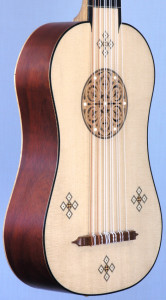 or (in Italian) "viola da mano", a guitar-like instrument of the 15th and 16th centuries, is widely considered to have been a seminal influence in the development of the guitar. It had six courses (usually), lute-like tuning in fourths and a guitar-like body, although early representations reveal an instrument with a sharply cut waist. It was also larger than the contemporary four course guitars. By the late 15th century some vihuelas were played with a bow, leading to the development of the viol. By the sixteenth century the vihuela's construction had more in common with the modern guitar, with its curved one-piece ribs, than with the viols, and more like a larger version of the contemporary four-course guitars. The vihuela enjoyed only a short period of popularity in Spain and Italy during an era dominated elsewhere in Europe by the lute; the last surviving published music for the instrument appeared in 1576. Meanwhile the five-course baroque guitar, which was documented in Spain from the middle of the 16th century, enjoyed popularity, especially in Spain, Italy and France from the late 16th century to the mid 18th century. Confusingly, in Portugal, the word vihuela referred to the guitar, whereas guitarra meant the "Portuguese guitar", a variety of cittern.
or (in Italian) "viola da mano", a guitar-like instrument of the 15th and 16th centuries, is widely considered to have been a seminal influence in the development of the guitar. It had six courses (usually), lute-like tuning in fourths and a guitar-like body, although early representations reveal an instrument with a sharply cut waist. It was also larger than the contemporary four course guitars. By the late 15th century some vihuelas were played with a bow, leading to the development of the viol. By the sixteenth century the vihuela's construction had more in common with the modern guitar, with its curved one-piece ribs, than with the viols, and more like a larger version of the contemporary four-course guitars. The vihuela enjoyed only a short period of popularity in Spain and Italy during an era dominated elsewhere in Europe by the lute; the last surviving published music for the instrument appeared in 1576. Meanwhile the five-course baroque guitar, which was documented in Spain from the middle of the 16th century, enjoyed popularity, especially in Spain, Italy and France from the late 16th century to the mid 18th century. Confusingly, in Portugal, the word vihuela referred to the guitar, whereas guitarra meant the "Portuguese guitar", a variety of cittern.
TUNNING
The guitar is a transposing instrument. Its pitch sounds one octave lower than it is notated on a score.
A variety of tunings may be used. The most common tuning, known as "Standard Tuning," has the strings tuned from a low E, to a high E, traversing a two octave range—EADGBE. When all strings are played open the resulting chord is an Em7/add11.
The pitches are as follows:
| String | Scientific pitch | Helmholtz pitch | Interval from middle C | Frequency |
| first | E4 | e' | major third above | 329.63 Hz |
| second | B3 | b | minor second below | 246.94 Hz |
| third | G3 | g | perfect fourth below | 196.00 Hz |
| fourth | D3 | d | minor seventh below | 146.83 Hz |
| fifth | A2 | A | minor tenth below | 110 Hz |
| sixth | E2 | E | minor thirteenth below | 82.41 Hz |
The table below shows a pitch's name found over the six strings of a guitar in standard tuning, from the nut (zero), to the twelfth fret.
| 0 | 1 | 2 | 3 | 4 | 5 | 6 | 7 | 8 | 9 | 10 | 11 | 12 |
| E | F | F♯ | G | A♭ | A | B♭ | B | C | C♯ | D | E♭ | E |
| B | C | C♯ | D | E♭ | E | F | F♯ | G | A♭ | A | B♭ | B |
| G | A♭ | A | B♭ | B | C | C♯ | D | E♭ | E | F | F♯ | G |
| D | E♭ | E | F | F♯ | G | A♭ | A | B♭ | B | C | C♯ | D |
| A | B♭ | B | C | C♯ | D | E♭ | E | F | F♯ | G | A♭ | A |
| E | F | F♯ | G | A♭ | A | B♭ | B | C | C♯ | D | E♭ | E |
A guitar using this tuning can tune to itself using the fact, with a single exception, that the 5th fret on one string is the same note as the next open string; that is, a 5th-fret note on the sixth string is the same note as the open fifth string. The exception is the interval between the second and third strings, in which the 4th-fret note on the third string is equivalent to the open second string.
Standard tuning has evolved to provide a good compromise between simple fingering for many chords and the ability to play common scales with minimal left hand movement. Uniquely, the guitar's tuning allows for repeatable patterns, which also facilitates the ease of playing commonscales. There are also a variety of commonly used alternate tunings. Most of these are open tunings, i.e., the unfretted strings produce a simple chord, such as a G Major chord. Many open tunings, where all of the strings are tuned to a similar note or chord, are popular for slide guitar playing. Alternate tunings are used for two main reasons: the ease of playing and the variation in tone that can be achieved.
Many guitarists use a long established, centuries-old tuning variation where the lowest string is 'dropped' down a whole tone. Known as Drop-D (or dropped D) tuning it is, from low to high, DADGBE. This allows for open string tonic and dominant basses in the keys of D and D minor. It also enables simple fifths (powerchords) to be more easily played. Eddie Van Halen sometimes uses a device known as a 'D Tuna, ' which he patented.[16] It is a small lever, attached to the fine tuner of the 6th string on a Floyd Rose tremolo, which allows him to easily drop that string from E to D. Many contemporary rock bands retune all strings by several semi-tones, making, for example, Drop-C or Drop-B tunings, However this terminology is inconsistent with that of "drop-D" as "drop-D" refers to dropping a single string to the named pitch. Often these new tunings are also simply referred to as the "Standard" of the note in question e. g.–"D Standard" (DGcfad').
Some guitarists tune in straight fourths, avoiding the major third between the third and second strings. While this makes playing major and minor triads slightly more difficult, it facilitated playing chords with more complicated extended structures.[citation needed] One proponent of the straight fourth tuning (EADGCF) is Stanley Jordan.
As with all stringed instruments a large number of scordatura are possible on the guitar. A commonform of scordatura involves tuning the 3rd string to F♯ to mimic the standard tuning of the lute, especially when playing renaissance repertoire originally written for the lute.

